Zih-Ching Chen
Continual Pre-Training is (not) What You Need in Domain Adaption
Apr 18, 2025Abstract:The recent advances in Legal Large Language Models (LLMs) have transformed the landscape of legal research and practice by automating tasks, enhancing research precision, and supporting complex decision-making processes. However, effectively adapting LLMs to the legal domain remains challenging due to the complexity of legal reasoning, the need for precise interpretation of specialized language, and the potential for hallucinations. This paper examines the efficacy of Domain-Adaptive Continual Pre-Training (DACP) in improving the legal reasoning capabilities of LLMs. Through a series of experiments on legal reasoning tasks within the Taiwanese legal framework, we demonstrate that while DACP enhances domain-specific knowledge, it does not uniformly improve performance across all legal tasks. We discuss the trade-offs involved in DACP, particularly its impact on model generalization and performance in prompt-based tasks, and propose directions for future research to optimize domain adaptation strategies in legal AI.
How to Learn a New Language? An Efficient Solution for Self-Supervised Learning Models Unseen Languages Adaption in Low-Resource Scenario
Nov 27, 2024



Abstract:The utilization of speech Self-Supervised Learning (SSL) models achieves impressive performance on Automatic Speech Recognition (ASR). However, in low-resource language ASR, they encounter the domain mismatch problem between pre-trained and low-resource languages. Typical solutions like fine-tuning the SSL model suffer from high computation costs while using frozen SSL models as feature extractors comes with poor performance. To handle these issues, we extend a conventional efficient fine-tuning scheme based on the adapter. We add an extra intermediate adaptation to warm up the adapter and downstream model initialization. Remarkably, we update only 1-5% of the total model parameters to achieve the adaptation. Experimental results on the ML-SUPERB dataset show that our solution outperforms conventional efficient fine-tuning. It achieves up to a 28% relative improvement in the Character/Phoneme error rate when adapting to unseen languages.
NeKo: Toward Post Recognition Generative Correction Large Language Models with Task-Oriented Experts
Nov 08, 2024Abstract:Construction of a general-purpose post-recognition error corrector poses a crucial question: how can we most effectively train a model on a large mixture of domain datasets? The answer would lie in learning dataset-specific features and digesting their knowledge in a single model. Previous methods achieve this by having separate correction language models, resulting in a significant increase in parameters. In this work, we present Mixture-of-Experts as a solution, highlighting that MoEs are much more than a scalability tool. We propose a Multi-Task Correction MoE, where we train the experts to become an ``expert'' of speech-to-text, language-to-text and vision-to-text datasets by learning to route each dataset's tokens to its mapped expert. Experiments on the Open ASR Leaderboard show that we explore a new state-of-the-art performance by achieving an average relative $5.0$% WER reduction and substantial improvements in BLEU scores for speech and translation tasks. On zero-shot evaluation, NeKo outperforms GPT-3.5 and Claude-Opus with $15.5$% to $27.6$% relative WER reduction in the Hyporadise benchmark. NeKo performs competitively on grammar and post-OCR correction as a multi-task model.
Leave No Knowledge Behind During Knowledge Distillation: Towards Practical and Effective Knowledge Distillation for Code-Switching ASR Using Realistic Data
Jul 15, 2024Abstract:Recent advances in automatic speech recognition (ASR) often rely on large speech foundation models for generating high-quality transcriptions. However, these models can be impractical due to limited computing resources. The situation is even more severe in terms of more realistic or difficult scenarios, such as code-switching ASR (CS-ASR). To address this, we present a framework for developing more efficient models for CS-ASR through knowledge distillation using realistic speech-only data. Our proposed method, Leave No Knowledge Behind During Knowledge Distillation (K$^2$D), leverages both the teacher model's knowledge and additional insights from a small auxiliary model. We evaluate our approach on two in-domain and two out-domain datasets, demonstrating that K$^2$D is effective. By conducting K$^2$D on the unlabeled realistic data, we have successfully obtained a 2-time smaller model with 5-time faster generation speed while outperforming the baseline methods and the teacher model on all the testing sets. We have made our model publicly available on Hugging Face (https://huggingface.co/andybi7676/k2d-whisper.zh-en).
PEFT for Speech: Unveiling Optimal Placement, Merging Strategies, and Ensemble Techniques
Jan 04, 2024Abstract:Parameter-Efficient Fine-Tuning (PEFT) is increasingly recognized as an effective method in speech processing. However, the optimal approach and the placement of PEFT methods remain inconclusive. Our study conducts extensive experiments to compare different PEFT methods and their layer-wise placement adapting Differentiable Architecture Search (DARTS). We also explore the use of ensemble learning to leverage diverse PEFT strategies. The results reveal that DARTS does not outperform the baseline approach, which involves inserting the same PEFT method into all layers of a Self-Supervised Learning (SSL) model. In contrast, an ensemble learning approach, particularly one employing majority voting, demonstrates superior performance. Our statistical evidence indicates that different PEFT methods learn in varied ways. This variation might explain why the synergistic integration of various PEFT methods through ensemble learning can harness their unique learning capabilities more effectively compared to individual layer-wise optimization.
How to Estimate Model Transferability of Pre-Trained Speech Models?
Jun 01, 2023Abstract:In this work, we introduce a ``score-based assessment'' framework for estimating the transferability of pre-trained speech models (PSMs) for fine-tuning target tasks. We leverage upon two representation theories, Bayesian likelihood estimation and optimal transport, to generate rank scores for the PSM candidates using the extracted representations. Our framework efficiently computes transferability scores without actual fine-tuning of candidate models or layers by making a temporal independent hypothesis. We evaluate some popular supervised speech models (e.g., Conformer RNN-Transducer) and self-supervised speech models (e.g., HuBERT) in cross-layer and cross-model settings using public data. Experimental results show a high Spearman's rank correlation and low $p$-value between our estimation framework and fine-tuning ground truth. Our proposed transferability framework requires less computational time and resources, making it a resource-saving and time-efficient approach for tuning speech foundation models.
CHAPTER: Exploiting Convolutional Neural Network Adapters for Self-supervised Speech Models
Dec 01, 2022Abstract:Self-supervised learning (SSL) is a powerful technique for learning representations from unlabeled data. Transformer based models such as HuBERT, which consist a feature extractor and transformer layers, are leading the field in the speech domain. SSL models are fine-tuned on a wide range of downstream tasks, which involves re-training the majority of the model for each task. Previous studies have introduced applying adapters, which are small lightweight modules commonly used in Natural Language Processing (NLP) to adapt pre-trained models to new tasks. However, such efficient tuning techniques only provide adaptation at the transformer layer, but failed to perform adaptation at the feature extractor. In this paper, we propose CHAPTER, an efficient tuning method specifically designed for SSL speech model, by applying CNN adapters at the feature extractor. Using this method, we can only fine-tune fewer than 5% of parameters per task compared to fully fine-tuning and achieve better and more stable performance. We empirically found that adding CNN adapters to the feature extractor can help the adaptation on emotion and speaker tasks. For instance, the accuracy of SID is improved from 87.71 to 91.56, and the accuracy of ER is improved by 5%.
Exploring Efficient-tuning Methods in Self-supervised Speech Models
Oct 10, 2022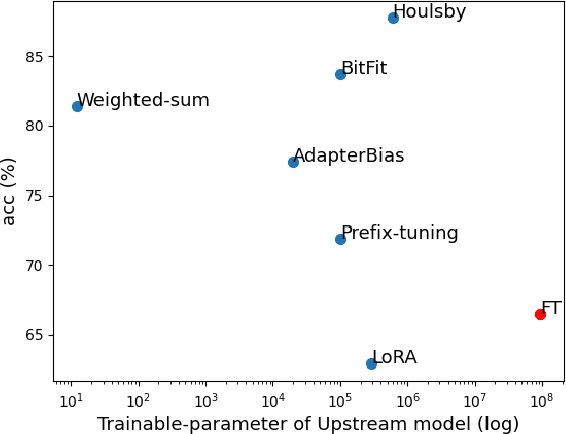

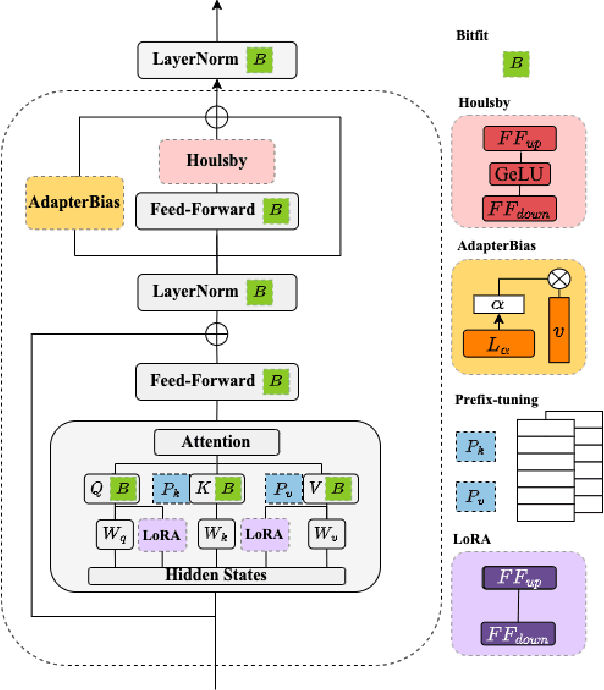

Abstract:In this study, we aim to explore efficient tuning methods for speech self-supervised learning. Recent studies show that self-supervised learning (SSL) can learn powerful representations for different speech tasks. However, fine-tuning pre-trained models for each downstream task is parameter-inefficient since SSL models are notoriously large with millions of parameters. Adapters are lightweight modules commonly used in NLP to solve this problem. In downstream tasks, the parameters of SSL models are frozen, and only the adapters are trained. Given the lack of studies generally exploring the effectiveness of adapters for self-supervised speech tasks, we intend to fill this gap by adding various adapter modules in pre-trained speech SSL models. We show that the performance parity can be achieved with over 90% parameter reduction, and discussed the pros and cons of efficient tuning techniques. This is the first comprehensive investigation of various adapter types across speech tasks.
Learning Facial Liveness Representation for Domain Generalized Face Anti-spoofing
Aug 16, 2022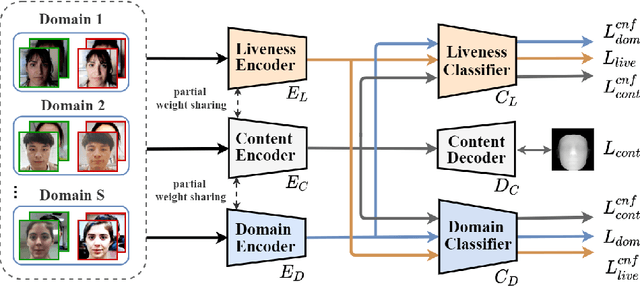


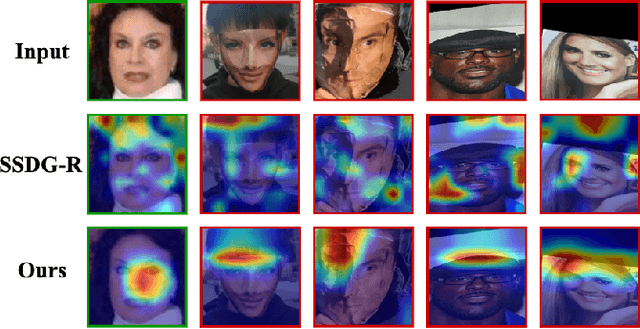
Abstract:Face anti-spoofing (FAS) aims at distinguishing face spoof attacks from the authentic ones, which is typically approached by learning proper models for performing the associated classification task. In practice, one would expect such models to be generalized to FAS in different image domains. Moreover, it is not practical to assume that the type of spoof attacks would be known in advance. In this paper, we propose a deep learning model for addressing the aforementioned domain-generalized face anti-spoofing task. In particular, our proposed network is able to disentangle facial liveness representation from the irrelevant ones (i.e., facial content and image domain features). The resulting liveness representation exhibits sufficient domain invariant properties, and thus it can be applied for performing domain-generalized FAS. In our experiments, we conduct experiments on five benchmark datasets with various settings, and we verify that our model performs favorably against state-of-the-art approaches in identifying novel types of spoof attacks in unseen image domains.
AdapterBias: Parameter-efficient Token-dependent Representation Shift for Adapters in NLP Tasks
Apr 30, 2022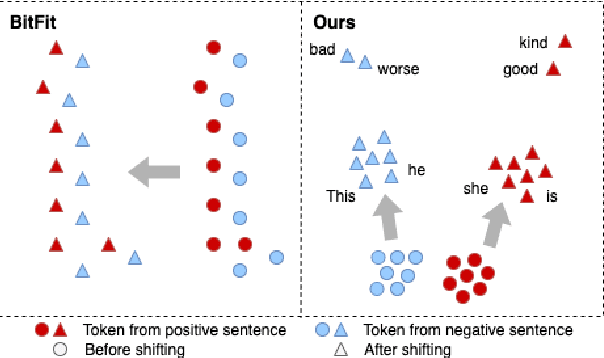

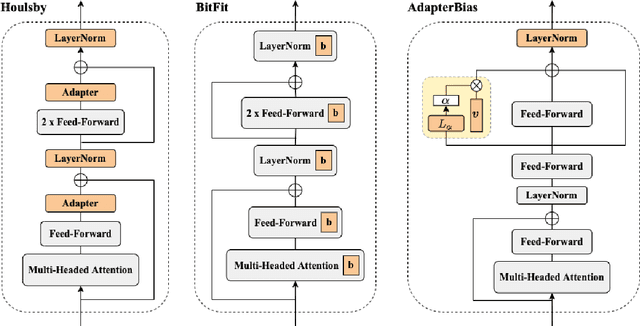
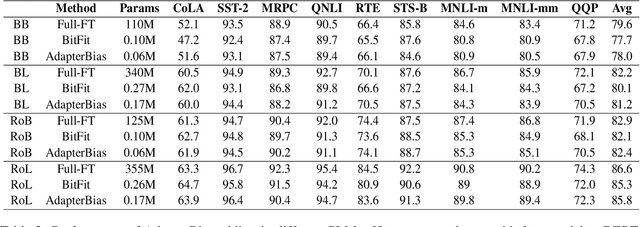
Abstract:Transformer-based pre-trained models with millions of parameters require large storage. Recent approaches tackle this shortcoming by training adapters, but these approaches still require a relatively large number of parameters. In this study, AdapterBias, a surprisingly simple yet effective adapter architecture, is proposed. AdapterBias adds a token-dependent shift to the hidden output of transformer layers to adapt to downstream tasks with only a vector and a linear layer. Extensive experiments are conducted to demonstrate the effectiveness of AdapterBias. The experiments show that our proposed method can dramatically reduce the trainable parameters compared to the previous works with a minimal decrease in task performances compared with fine-tuned pre-trained models. We further find that AdapterBias automatically learns to assign more significant representation shifts to the tokens related to the task in consideration.
 Add to Chrome
Add to Chrome Add to Firefox
Add to Firefox Add to Edge
Add to Edge